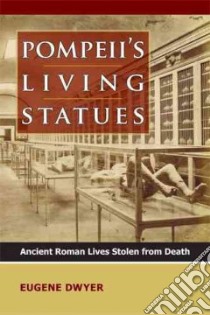Pompeii's Living Statues - 9780472117277
Un libro in lingua di Eugene Dwyer edito da Univ of Michigan Pr, 2010
- € 60.50
- Il prezzo è variabile in funzione del cambio della valuta d’origine
In A.D. 79, Mt. Vesuvius erupted in two stages. While the first stage was incredibly destructive, it was the second stage, a so-called pyroclastic flow, that inundated the town with a combination of superheated gases, pumice, and rocks, killing tens of thousands of people and animals and burying them in ash and mud.
During excavations of the town in 1863, Giuseppe Fiorelli, the director of the dig, poured plaster of paris into a cavity under the soil revealed by a workman's pick. When the plaster set and the mound was uncovered, all were amazed to see the secret that the ground had held for 1,800 years: a detailed cast of an ancient Pompeian such as no one had seen before, frozen in the instant of dying and complete in every respect, including outlines of the clothes he was wearing at the time of the destruction. The bodies, photographed and exhibited in the specially built Pompeii Museum, completely changed the world's ideas of life in ancient Italy.
Pompeii's Living Statues is a narrative account, supported by contemporary documents, of the remarkable discovery of those ancient victims preserved in the volcanic mud of Vesuvius.
Eugene Dwyer examines these casts and related records, the originals of a number of which (along with their museum) were lost in WWII bombing. As he considers the casts as archaeological and cultural pieces, he also discusses Pompeii and its artifacts in the context of Italian unification and party politics, the development of modern excavation methods, and the challenges of maintaining a very large archaeological site. Dwyer's clear organization and writing style, combined with a collection of photographs and engravings, make for a fascinating exploration of Pompeii and its victims.
Eugene Dwyer is Professor of Art History at Kenyon College. Trained at Harvard and the Institute of Fine Arts at New York University, he has contributed articles to numerous volumes on Italian architecture and archaeology published by presses including Cambridge, the Getty, Johns Hopkins, and the University of Michigan Press.
Informazioni bibliografiche
- Titolo del Libro in lingua: Pompeii's Living Statues
- Sottotitolo: Ancient Roman Lives Stolen from Death
- Lingua: English
- Autore: Eugene Dwyer
- Editore: Univ of Michigan Pr
- Collana: Univ of Michigan Pr (Hardcover)
- Data di Pubblicazione: 17 Maggio '10
- Genere: SOCIAL SCIENCE
- Argomenti : Excavations (Archaeology) Italy Pompeii (Extinct city Human remains (Archaeology) Italy Pompeii (Extinct city) History Disaster victims Italy Pompeii (Extinct city) History
- Pagine: 159
- ISBN-10: 0472117270
- EAN-13: 9780472117277


